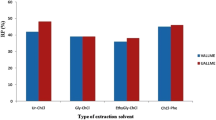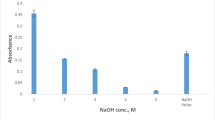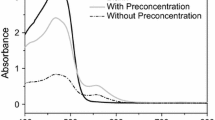Abstract
In this study, trace amounts of thorium ions were extracted using a highly sensitive, selective, rapid and simple micro-funnel magnetic stirring-assisted liquid–liquid microextraction method, and determined by UV–Vis spectrophotometry. Tri-n-octylphosphine oxide was used as the complexing agent during the microextraction process, and Arsenazo III was applied as the chromogenic reagent through spectrophotometric determination. The effective parameters on extraction efficiency were optimized by experimental design methods. Under the optimum conditions, detection limit, relative standard deviation and the enrichment factor were 0.98 μg L−1, 0.69% and 152, respectively. The calibration graph was linear over the range of 5–250 μg L−1.







Similar content being viewed by others
References
Yaftian MR, Zamani AA, Rostamnia S (2006) Thorium (IV) ion selective transport through a bulk liquid membrane containing 2-thenoyltrifluoroacetone as extractant-carrier. Sep Purif Technol 49(1):71–75
Aydin FA, Soylak M (2007) Solid phase extraction and preconcentration of uranium (VI) and thorium (IV) on Duolite XAD761 prior to their inductively coupled plasma mass spectrometric determination. Talanta 72(1):187–192
Suleymanov B, Ahmedov M, Safarova K, Steinnes E (2010) Metals in main rivers of azerbaijan: influence of transboundary pollution. Water Air Soil Pollut 213(1–4):301–310
Laferriere BD, Maiti TC, Arnquist IJ, Hoppe EW (2015) A novel assay method for the trace determination of Th and U in copper and lead using inductively coupled plasma mass spectrometry. Nucl Instrum Methods Phys Res 775:93–98
Deb SB, Saxena MK, Nagar BK, Ramakumar KL (2008) Determination of trace amounts of thorium in a uranium matrix by inductively coupled plasma mass spectrometry and validation of the separation procedure by standard addition and tracer techniques. At Spectrosc 29:39–44
Shrivastav P, Menon SK, Agrawal YK (2001) Selective extraction and inductively coupled plasma atomic emission spectrophotometric determination of thorium using chromogenic crown ether. J Radioanal Nucl Chem 250(3):459–464
Rastegarzadeh S, Pourreza N, Saeedi I (2010) An optical chemical sensor for thorium (IV) determination based on thorin. J Hazard Mater 173(1–3):110–114
Safavi A, Sadeghi M (2006) Design and evaluation of a thorium (IV) selective optode. Anal Chim Acta 567(2):184–188
Ganjali MR, Norouzi P, Faridbod F, Riahi S, Yaftian MR, Zamani A et al (2007) Highly selective and sensitive Th4+-PVC-based membrane sensor based on 2(diphenylphosphorothioyl)-N0, N0-diphenylacetamide. J Appl Electrochem 37(7):827–833
Arida HA, Ahmed MA, El-Saied AM (2003) A novel coated graphite rod Th(IV) ion selective electrode based on thorium oxinate complex and its application. Sensors 3(10):424–437
Kadam RB, Mali GG, Mohite BS (2013) Analytical application of poly [dibenzo-18-crown 6] for chromatographic separation of thorium (IV) from uranium (VI) and other elements in glycine medium. J Radioanal Nucl Chem 295(1):501–511
Rozmarić M, Ivsić AG, Grahek Z (2009) Determination of uranium and thorium in complex samples using chromatographic separation. ICP-MS and spectrophotometric detection. Talanta 80(1):352–362
Khan MH, Hafeez M, Bukhari SMH, Ali A (2014) Spectrophotometric determination of microamounts of thorium with thorin in the presence of cetylpyridinium chloride as surfactant in perchloric acid. J Radioanal Nucl Chem 301(3):703–709
Al-Kady AS (2012) Optimized and validated spectrophotometric methods for the determination of trace amounts of uranium and thorium using 4-chloro-N-(2, 6 dimethylphenyl)-2-hydroxy-5- sulfamoylbenzamide. Sens Actuators B 166–167:485–491
Niazi A (2006) Spectrophotometric simultaneous determination of uranium and thorium using partial least squares regression and orthogonal signal correction. J Braz Chem Soc 17:1020–1026
Zhijun G, Wangsuo W, Dadong S, Minyu T (2003) Liquid–liquid extraction of uranium (VI) and thorium (IV) by two open-chain crown ethers with terminal quinolyl groups in chloroform. J Radioanal Nucl Chem 258(1):199–203
Yousefi SR, Zolfonoun E (2016) On-line solid phase extraction using ion-pair microparticles combined with ICP-OES for the simultaneous preconcentration and determination of uranium and thorium. Radiochim Acta 104(11):801–807
Saha A, Deb SB, Sarkar A, Saxena MK, Tomar BS (2016) Simultaneous preconcentration of uranium and thorium in aqueous samples using cloud point extraction. RSC Adv 6:20109–20119
Rezaei M, Assadi Y, Hosseini MRM, Aghaee E, Ahmadi F, Berijani S (2006) Determination of organic compounds in water using dispersive liquid–liquid microextraction. J Chromatogr A 1116(1–2):1–9
Zhang Y, Lee HK (2013) Low-density solvent-based vortex-assisted surfactant-enhanced-emulsification liquid–liquid microextraction combined with gas chromatography–mass spectrometry for the fast determination of phthalate esters in bottled water. J Chromatogr A 1274:28–35
Farajzadeh MA, Djozan D, Khorram P (2011) Development of a new microextraction method based on a dynamic single drop in a narrow-bore tube: application in extraction and preconcentration of some organic pollutants in well water and grape juice samples. Talanta 85(2):1135–1142
Ezoddin M, Abdi K, Esmaeili N (2016) Ultrasound enhanced air-assisted surfactant liquid–liquid microextraction based on the solidification of an organic droplet for the determination of chromium in water, air and biological samples. Microchem J 129:200–204
Hosseini M, Heydari R, Alimoradi M (2014) Vortex and air assisted liquid–liquid microextraction as a sample preparation method for high-performed liquid chromatography determinations. Talanta 130:171–176
Heydari F, Ramezani M (2017) Application of response surface methodology for optimization and determination of palladium by in-tube ultrasonic and air-assisted liquid–liquid microextraction coupled with flame atomic absorption spectrometry. Sep Sci Technol 52(10):1643–1651
Cabala R, Bursova M (2012) Bell-shaped extraction device assisted liquid–liquid microextraction technique and its optimization using response-surface methodology. J Chromatogr A 1230:24–29
Farahani A, Ramezani M, Hassan J (2017) Microfunnel magnetic stirring-assisted dispersive liquid–liquid microextraction derivatization technique for the determination of 3-chloro-4-(dichloromethyl)-5-hydroxy-2(5H)-furanone (Mutagen X) in aqueous samples by GC-ECD. Sep Sci Technol 52(9):1505–1511
Asfaram A, Ghaedi M, Goudarzi A (2016) Optimization of ultrasound-assisted dispersive solid-phase microextraction based on nanoparticles followed by spectrophotometry for the simultaneous determination of dyes using experimental design. Ultrason Sonochem 32:407–417
Zhou Y, Song JZ, Choi FFK, Wu HF, Qiao CF, Ding LS et al (2009) An experimental design approach using response surface techniques to obtain optimal liquid chromatography and mass spectrometry conditions to determine the alkaloids in Meconopsi species. J Chromatogr A 1216(42):7013–7023
Ghasemi JB, Zolfonoun E (2010) Simultaneous spectrophotometric determination of trace amounts of uranium, thorium, and zirconium using the partial least squares method after their preconcentration by α-benzoin oxime modified Amberlite XAD-2000 resin. Talanta 80(3):1191–1197
Jain VK, Pandya RA, Pillai SG, Shrivastav PS (2006) Simultaneous preconcentration of uranium (VI) and thorium (IV) from aqueous solutions using a chelating calix[4] arene anchored chloromethylated polystyrene solid phase. Talanta 70(2):257–266
Veyseh S, Niazi A (2017) Flotation-assisted homogeneous liquid–liquid microextraction for determination of thorium in water samples by inductively coupled plasma–mass spectrometry and Box-Behnken design. Sep Sci Technol 52(7):1289–1297
Zolfonoun E, Salahinejad M (2013) Preconcentration procedure using vortex-assisted liquid–liquid microextraction for the fast determination of trace levels of thorium in water samples. J Radioanal Nucl Chem 298(3):1801–1807
Rezaee M, Khalilian F (2016) A novel method for the determination of trace thorium by dispersive liquid–liquid microextraction based on solidification of flotation organic drop. Quim Nova 39(2):167–171
Acknowledgement
Financial support from the Azad University of Arak is gratefully acknowledged.
Author information
Authors and Affiliations
Corresponding author
Additional information
Publisher's Note
Springer Nature remains neutral with regard to jurisdictional claims in published maps and institutional affiliations.
Rights and permissions
About this article
Cite this article
Heydari, F., Ramezani, M. Micro-funnel magnetic stirring-assisted liquid–liquid microextraction technique combined with UV–Vis spectrophotometry for determination of thorium in aqueous samples with the aid of experimental design. J Radioanal Nucl Chem 320, 27–36 (2019). https://doi.org/10.1007/s10967-019-06452-6
Received:
Published:
Issue Date:
DOI: https://doi.org/10.1007/s10967-019-06452-6




